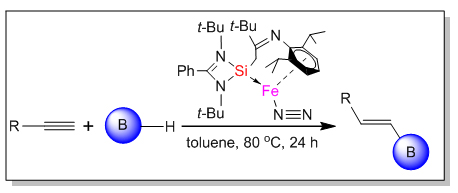[1] (a) Trinquier, G. J. Am. Chem. Soc. 1990, 112, 2130. (b) Apeloig, Y.; Pauncz, R.; Miriam, K.; West, R. Steiner, W.; Chapman, D. Organometallics 2003, 22, 3250. (c) Sasamori, T.; Tokitoh, N. In Encyclopedia of Inorganic Chemistry II, Ed.: King, R. B., John Wiley & Sons: Chichester, U.K., 2005, p. 1698.
[2] For selected papers: (a) Blom, B.; Stoelzel, M.; Driess. M. Chem. Eur. J. 2013, 19, 40. (b) Blom, B.; Gallego, D.; Driess, M. Inorg. Chem. Front. 2014, 1, 134. (c) Zhou, Y.-P.; Driess. M. Angew. Chem. Int. Ed. 2019, 58, 3715. (d) Raoufmoghaddam, S.; Zhou, Y. P.; Wang, Y.; Driess, M. J. Organomet. Chem. 2017, 829, 2. (e) Haaf, M.; Schmedake, T. A.; West, R. Acc. Chem. Res. 2000, 33, 704. (f) Yao, S.; Xiong, Y.; Driess, M. Organometallics 2011, 30, 1748. (g) Cui, H.; Teng, P.; Zhang, E.; Lu, J.; Zhang, F.; Wu, M. Chin. J. Chem. 2017, 35, 401. (h) Cui, H.; Cui, C. Chin. J. Org. Chem. 2016, 36, 626 (in Chinese). (崔海燕, 崔春明, 有机化学, 2016, 36, 626.)
[3] (a) Jutzi, P.; Kanne, D.; Krfiger, C. Angew. Chem. Int. Ed. 1986, 25, 164. (b) Blom, B.; Stoelzel, M.; Driess. M. Chem. Eur. J. 2013, 19, 40. (c) Zhou, L.; Li, Y.; Lin, F.; Tian, D.; Lei, Q.; Fang, W.; Xie, H. Chin. J. Org. Chem. 2015, 35, 698 (in Chinese). (周莉, 李阳, 林芙蓉, 田迪英, 雷群芳, 方文军, 谢湖均, 有机化学, 2015, 35, 698.) (d) Wang, L.; Guo, J.; Li, Y.; Su, Y.; Liu, J.; Li, Y.; Wang, S.; Shimada, S.; Huang, W. Chin. J. Chem. 2017, 35, 507.
[4] (a) Troadec, T.; Prades, A.; Rodriguez, R.; Mirgalet, R.; Baceiredo, A.; Saffon-Merceron, N.; Branchadell, V.; Kato, T. Inorg. Chem. 2016, 55, 8234. (b) Iimura, T.; Akasaka, N.; Iwamoto, T. Organometallics 2016, 35, 4071. (c) Iimura, T.; Akasaka, N.; Kosai, T.; Iwamoto, T. Dalton Trans. 2017, 46, 8868.
[5] (a) Cabeza, J. A.; García-Álvarez, P.; González-Álvarez, L. Chem. Commun. 2017, 53, 10275. (b) Ren, H.; Zhou, Y.-P.; Bai, Y.; Cui, C.; Driess, M. Chem. Eur. J. 2017, 23, 5663. (c) Brück, A.; Gallego, D.; Wang, W.; Irran, E.; Driess, M.; Hartwig, J. F. Angew. Chem. Int. Ed. 2012, 51, 11478. (d) Zhou, Y.-P.; Raoufmoghaddam, S.; Szilvási, T.; Driess, M. Angew. Chem. Int. Ed. 2016, 55, 12868. (e) Wang, Y.; Kostenko, A.; Yao, S.; Driess, M. J. Am. Chem. Soc. 2017, 139, 13499.
[6] (a) Fürstner, A.; Krause, H.; Lehmann, C. W. Chem. Commun. 2001, 2372. (b) Khoo, S.; Cao, J.; Yang, M.-C.; Shan, Y.-L.; Su, M.-D.; So, C.-W. Chem. Eur. J. 2018, 24, 14329. (c) Zhang, M.; Liu, X.; Shi, C.; Ren, C.; Ding, Y.; Roesky, H. W. Z. Anorg. Allg. Chem. 2008, 634, 1755. (d) Gallego, D.; Brgck, A.; Irran, E.; Meier, F.; Kaupp, M.; Driess, M.; Hartwig, J. F. J. Am. Chem. Soc. 2013, 135, 15617. (e) Tan, G.; Enthaler, S.; Inoue, S.; Blom, B.; Driess, M. Angew. Chem. Int. Ed. 2015, 54, 2214. (f) Qi, X.; Sun, H.; Li, X.; Fuhr, O.; Fenske, D. Dalton Trans. 2018, 47, 2581. (g) Mo, Z.; Kostenko, A.; Zhou, Y.-P.; Yao, S.; Driess, M. Chem. Eur. J. 2018, 24, 14608. (h) Schmidt, M.; Blom, B.; Szilvási, T.; Schomäcker, R.; Driess, M. Eur. J. Inorg. Chem. 2017, 1284. (i) Someya, C. I.; Haberberger, M.; Wang, W.; Enthaler, S.; Inoue, S. Chem. Lett. 2013, 42, 286.
[7] (a) Bracher, F.; Litz, T.; J. Prakt. Chem./Chem.-Ztg. 1996, 338, 386. (b) Brown, H. C.; Chen, J. J. Org. Chem. 1981, 46, 3978. (c) Brown, H. C.; Rao, B. S. J. Am. Chem. Soc. 1959, 81, 6423. (d) Crockett, M. P.; Tyrol, C. C.; Wong, A. S.; Li, B.; Byers, J. A. Org. Lett. 2018, 20, 5233. (e) Hartwig, J. F. Acc. Chem. Res. 2011, 45, 864. (e) Martin, R.; Buchwald, S. L. Acc. Chem. Res. 2008, 41, 1461. (f) Miyaura, N.; Suzuki, A. Chem. Rev. 1995, 95, 2457.
[8] Haberberger, M.; Enthaler, S. Chem. Asian J. 2013, 8, 50.
[9] Greenhalgh, M. D.; Thomas, S. P. Chem. Commun. 2013, 49, 11230.
[10] Nakajima, K.; Kato, T.; Nishibayashi, Y. Org. Lett. 2017, 19, 4323.
[11] Singh, A.; Shafiei-Haghighi, S.; Smith, C. R.; Unruh, D. K.; Findlater, M. Asian J. Org. Chem. 2020, 9, 416.
[12] Bai, Y.; Zhang, J.; Cui, C. Chem. Commun. 2018, 54, 8124.
[13] (a) Docherty, J. H.; Peng, J.; Dominey, A. P.; Thomas, S. P. Nat. Chem. 2017, 9, 595. (b) Gorgas, N.; Alves, L. G.; Stöger, B.; Martins, A. M.; Veiros, L. F.; Kirchner, K. J. Am. Chem. Soc. 2017, 139, 8130. |
